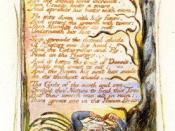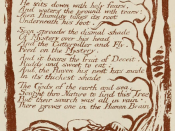William Blake, one of the earliest and greatest figures of Romanticism, wrote the "Songs of Innocence and Experience" in the 1790s. The poems juxtapose the innocent, pastoral world of childhood against an adult world of corruption and repression. The collection explores the value and limitations of two different perspectives on the world. Many of the poems are in pairs, so that the same situation or problem is seen through the lens of innocence first and then experience. "A Divine Image" and "The Human Abstract" are two companion poems that look at the virtues Mercy, Pity, Peace and Love. Both poems possess contrasting philosophies pertaining to the virtues. "A Divine Image," a song of innocence, strives for reverence on the one hand, while "The Human Abstract" exhibits cynicism.
In "A Divine Image" Blake writes about God and his existence within humanity.
The personified figures of Mercy, Pity, Peace and Love are listed as four virtues of delight. The speaker states that everyone prays to these in times of distress and thanks them for blessings because they represent "God, our Father dear." In addition, the virtues are characteristics of humanity. Mercy is found inside the human heart, pity in the human face, peace envelops humans, and love exists in the "human form divine." To further prove that man and God are alike "the four virtues that Blake assigns are the ones conventionally associated with Jesus, who was both man and God" (Gleckner 37).
Blake creates a world of brotherhood, acceptance and the sense of community spirit among mankind in the third stanza.
Then every man, of every clime,
That prays in his distress,
Prays to the human form divine,
Love, Mercy, Pity, Peace.
"All people in the world must love and respect...


